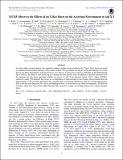NICER Observes the Effects of an X-Ray Burst on the Accretion Environment in Aql X-1
Author(s)
Keek, L.; Arzoumanian, Z.; Bult, P.; Cackett, E. M.; Chenevez, J.; Fabian, A. C.; Gendreau, K. C.; Guillot, S.; Güver, T.; Homan, J.; Jaisawal, G. K.; Lamb, F. K.; Ludlam, R. M.; Mahmoodifar, S.; Markwardt, C. B.; Miller, J. M.; Soong, Y.; Strohmayer, T. E.; Wolff, M. T.; Chakrabarty, Deepto; Prigozhin, Gregory; ... Show more Show less
DownloadKeek_2018_ApJL_855_L4.pdf (749.4Kb)
PUBLISHER_POLICY
Publisher Policy
Article is made available in accordance with the publisher's policy and may be subject to US copyright law. Please refer to the publisher's site for terms of use.
Terms of use
Metadata
Show full item recordAbstract
Accretion disks around neutron stars regularly undergo sudden strong irradiation by Type-I X-ray bursts powered by unstable thermonuclear burning on the stellar surface. We investigate the impact on the disk during one of the first X-ray burst observations with the Neutron Star Interior Composition Explorer (NICER) on the International Space Station. The burst is seen from Aql X-1 during the hard spectral state. In addition to thermal emission from the neutron star, the burst spectrum exhibits an excess of soft X-ray photons below 1 keV, where NICER's sensitivity peaks. We interpret the excess as a combination of reprocessing by the strongly photoionized disk and enhancement of the pre-burst persistent flux, possibly due to Poynting-Robertson drag or coronal reprocessing. This is the first such detection for a short sub-Eddington burst. As these bursts are observed frequently, NICER will be able to study how X-ray bursts affect the disk and corona for a range of accreting neutron star systems and disk states. Key words: accretion, accretion disks – stars: individual (Aql X-1) – stars: neutron – X-rays: binaries – X-rays:
bursts
Date issued
2018-03Department
Massachusetts Institute of Technology. Department of Physics; MIT Kavli Institute for Astrophysics and Space ResearchJournal
The Astrophysical Journal
Publisher
American Astronomical Society
Citation
Keek, L., Z. Arzoumanian, P. Bult, E. M. Cackett, D. Chakrabarty, J. Chenevez, A. C. Fabian, et al. “NICER Observes the Effects of an X-Ray Burst on the Accretion Environment in Aql X-1.” The Astrophysical Journal 855, no. 1 (February 28, 2018): L4. © 2018 The American Astronomical Society.
Version: Final published version
ISSN
2041-8213